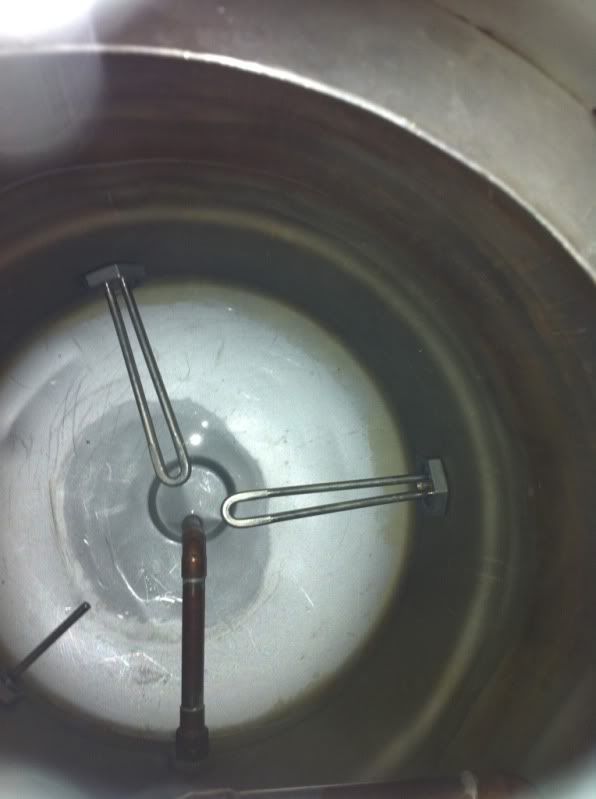klyph
Well-Known Member
With a pump that kicks a strong whirlpool, you'll still get a decent cone in the middle, but it won't work quite as well as without the element being there.

My opinion: Heatsticks scare the sh*t out of me and I would never use one.
I agree with the above. I think heat sticks are an electrocution waiting to happen. I will never criticize anyone for using one but I would never even think about using one.

I have a (maybe) stupid question about using heating elements, whether in a heat stick or mounted in your kettle.
How do you control the temeprature of your water? Right now I am forced to do concentrated wort boils on my gas stove in a 4 gallon pot because the stove lacks the power to boil 6 gallons for a full wort boil in my 10 gallon pot. But at least with gas I have *very* precise and immediate control over the temperature of my water.
Is it possible to get *some* sort of control (I'm assuming electric will always be inferior to gas/propane in this regard) with heating elements? I'm asking because I'm toying with the idea of making an all electric brewery in my basement, with elements mounted in my 10 gallon pot, so I can stay out of the kitchen.
Thanks!
Nick
Most do it with a PID/SSR combination.How do you control the temeprature of your water?
I'm afraid your assumption is incorrect.Is it possible to get *some* sort of control (I'm assuming electric will always be inferior to gas/propane in this regard) with heating elements?
I'm asking because I'm toying with the idea of making an all electric brewery in my basement.
A PID controller (proportional integral derivative controller) is a control loop feedback device that is used to continually calculate the difference between the target temperature and the measured temperature and takes the appropriate action to make up for any difference.
A PID controller is an intelligent device that learns and trains itself to the behaviour of a system so as to not overshoot or undershoot the target temperature. It is more advanced than most simple temperature controllers (such as those from Love Controls) that only look at the temperature. A PID controller also considers the rate of change of temperature. This means that as a PID controller sees the target temperature approaching, it knows to "slow down" so that it doesn't overshoot the temperature. A PID controller uses calculus to measure this rate of change instead of simply looking at "am I too high or too low?".
The end result is more a more consistent temperature, one that doesn't continually oscillate over and under the target temperature. The good news is that the PID controller does it all automatically for us. We don't have to have any understanding of how this all works (no need to remember your high school calculus!).
The Auber Instruments SYL-2352 PID controllers we use incorporate more advanced fuzzy logic as compared to some simpler PID controllers for even greater control. In our brewery when we set the target temperature the liquid ramps up to that temperature and stays there. That's really all we care about!
I just assumed that electric heating would be inferior to gas heating when it comes to temperature control because an electric stove is inferior to a gas stove in this regard. Gas responds much more quickly.
I'm left wondering how much one of these costs now, lol! They sound pricey.
If you heated and boiled your beer in the same way as you heat food on an electric stove, then possibly this comparison could be used. But there are differences. FWIW, I've owned both electric (corian cooktop) and gas ranges of various models. I find it's not possible to issue a blanket statement that for ranges gas is better than electric. It's all about how it's implemented. (My first 100% gas stove sucked as it was cheap piece of crap, my second all electric with corian cooktop was great and heated up fast, my current dual fuel [gas top, electric bottom] is too new to tell).
The "speed of response" also doesn't matter I don't think when you're heating 5-20 gallons of wort. There's so much thermal mass that it really doesn't make a difference if the electric element takes 10 seconds to heat up versus a gas element that has 100% heat in about 1 second.
Electric brewers have the element right in the liquid so that 100% of the heat goes into the liquid. Gas brewers probably lose 70-80% of the heat to the atmosphere (it goes around the pot).
Kal
I have a (maybe) stupid question about using heating elements, whether in a heat stick or mounted in your kettle.
How do you control the temeprature of your water? Right now I am forced to do concentrated wort boils on my gas stove in a 4 gallon pot because the stove lacks the power to boil 6 gallons for a full wort boil in my 10 gallon pot. But at least with gas I have *very* precise and immediate control over the temperature of my water.
Is it possible to get *some* sort of control (I'm assuming electric will always be inferior to gas/propane in this regard) with heating elements? I'm asking because I'm toying with the idea of making an all electric brewery in my basement, with elements mounted in my 10 gallon pot, so I can stay out of the kitchen.
Thanks!
Nick
Enter your email address to join: